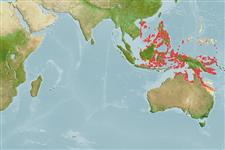Common names from other countries
Environment: milieu / climate zone / depth range / distribution range
Ecología
marino asociado a arrecife; rango de profundidad 2 - 15 m (Ref. 37816). Tropical
Western Pacific: Queensland and Borneo. Reported from the Philippines (Ref. 5454), Indonesia (Ref. 8631) and Papua New Guinea (Ref. 6771). Also from Palau (Ref.37816).
Length at first maturity / Tamaño / Peso / Age
Maturity: Lm ?, range 2 - ? cm
Max length : 5.0 cm SL macho / no sexado; (Ref. 48637)
Short description
Claves de identificación | Morfología | Morfometría
Espinas dorsales (total) : 2; Radios blandos dorsales (total) : 26 - 28; Radios blandos anales: 23 - 24. Body with 6 short dermal flaps. Males have distinctive ocellus above the front base of anal fin.
Collected from mixed sand-coral habitats. Lives mainly on coastal reefs and most often found on outcrops of coral in sheltered sandy bays subject to moderate tidal currents (Ref. 48637). Occurs singly or in groups among the branches of gorgonians, soft corals, or finely-branched fire corals (Ref. 37816, 48637).
Life cycle and mating behavior
Maturities | Reproducción | Spawnings | Egg(s) | Fecundities | Larva
Randall, J.E., G.R. Allen and R.C. Steene, 1990. Fishes of the Great Barrier Reef and Coral Sea. University of Hawaii Press, Honolulu, Hawaii. 506 p. (Ref. 2334)
IUCN Red List Status (Ref. 130435)
CITES (Ref. 128078)
Not Evaluated
Threat to humans
Harmless
Human uses
Herramientas
Special reports
Download XML
Fuentes de Internet
Estimates based on models
Preferred temperature (Ref.
115969): 27.4 - 28.6, mean 28.2 (based on 378 cells).
Phylogenetic diversity index (Ref.
82804): PD
50 = 0.6250 [Uniqueness, from 0.5 = low to 2.0 = high].
Bayesian length-weight: a=0.01995 (0.00943 - 0.04220), b=2.93 (2.75 - 3.11), in cm Total Length, based on LWR estimates for this (Sub)family-body shape (Ref.
93245).
Nivel trófico (Ref.
69278): 2.9 ±0.4 se; based on size and trophs of closest relatives
Resiliencia (Ref.
120179): Alto, población duplicada en un tiempo mínimo inferior a 15 meses (Preliminary K or Fecundity.).
Fishing Vulnerability (Ref.
59153): Low vulnerability (10 of 100).
